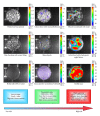Emetic Bacillus cereus are more volatile than thought: recent foodborne outbreaks and prevalence studies in Bavaria (2007-2013)
- PMID: 24895578
- PMCID: PMC4033357
- DOI: 10.1155/2014/465603
Emetic Bacillus cereus are more volatile than thought: recent foodborne outbreaks and prevalence studies in Bavaria (2007-2013)
Abstract
Several Bacillus cereus strains possess the genetic fittings to produce two different types of toxins, the heat-stable cereulide or different heat-labile proteins with enterotoxigenic potential. Unlike the diarrheal toxins, cereulide is (pre-)formed in food and can cause foodborne intoxications shortly after ingestion of contaminated food. Based on the widely self-limiting character of cereulide intoxications and rarely performed differential diagnostic in routine laboratories, the real incidence is largely unknown. Therefore, during a 7-year period about 4.300 food samples linked to foodborne illness with a preliminary report of vomiting as well as food analysed in the context of monitoring programs were investigated to determine the prevalence of emetic B. cereus in food environments. In addition, a lux-based real-time monitoring system was employed to assess the significance of the detection of emetic strains in different food matrices and to determine the actual risk of cereulide toxin production in different types of food. This comprehensive study showed that emetic strains are much more volatile than previously thought. Our survey highlights the importance and need of novel strategies to move from the currently taxonomic-driven diagnostic to more risk orientated diagnostics to improve food and consumer safety.
Figures



References
-
- Agata N, Ohta M, Mori M, Isobe M. A novel dodecadepsipeptide, cereulide, is an emetic toxin of Bacillus cereus . FEMS Microbiology Letters. 1995;129(1):17–20. - PubMed
-
- Ehling-Schulz M, Fricker M, Scherer S. Bacillus cereus, the causative agent of an emetic type of food-borne illness. Molecular Nutrition & Food Research. 2004;48(7):479–487. - PubMed
-
- Ehling-Schulz M, Messelhäusser U, Granum PE. Bacillus cereus in milk and dairy production. In: Hoorfar J, editor. Rapid Detection, Characterization and Enumeration of Food-Borne Pathogens. Washington, DC, USA: ASM Press; 2011. pp. 275–289.
-
- European Food Safety Authority (EFSA) Opinion of the scientific panel on biological hazards of Bacillus cereus and other Bacillus spp. in foodstuff. The EFSA Journal. 2005;175:1–48.
-
- European Food Safety Authority (EFSA) The European Union Summary report on trends and sources of zoonoses, zoonotic agents and food-borne outbreaks in 2011. The EFSA Journal. 2013;11(4)3129 - PubMed
Publication types
MeSH terms
LinkOut - more resources
Full Text Sources
Other Literature Sources
Medical

